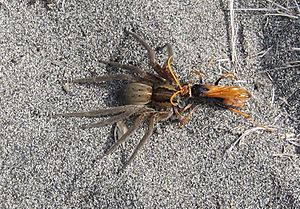Golden spider wasp facts for kids
Quick facts for kids Golden spider wasp |
|
|---|---|
 |
|
| Cryptocheilus australis dragging a nursery web spider | |
| Scientific classification | |
| Synonyms | |
|
The golden spider wasp, also known as Cryptocheilus australis, is a type of spider wasp. It comes from Australia but was accidentally brought to New Zealand around 1960.
Contents
What Does It Look Like?
These wasps are a bright reddish-yellow color. This is why they are called "golden spider wasps."
Female wasps are bigger than males. Females are about 16 to 22 millimeters long. Males are a bit smaller, around 11.6 to 18.5 millimeters long.
Life Cycle and Habits
Hunting for Spiders
Female golden spider wasps are expert hunters. They mostly use their eyesight to find spiders. They also use their antennae to smell for prey.
In New Zealand, they usually hunt spiders from the Pisauridae family. The wasp will chase a spider until it stops moving. Then, the wasp quickly stings the spider twice.
After the spider collapses, the wasp carefully stings it again. This strong sting makes the spider unable to move its legs. The spider is then paralyzed.
Moving the Prey
Once the spider is paralyzed, the female wasp grabs it. She holds the spider by its mouthparts and walks backward. She drags the spider with its back facing up.
Sometimes, the wasp will leave the spider for a moment. She does this to check on her nest. The spider is left hidden while she is gone.
Building a Nest
Golden spider wasps build their nests in places that are already there. They might use spaces under stones or cracks in hard clay. They also nest next to tree stumps or posts.
Before hunting, the female wasp builds a special cell for her egg. She also makes a passage leading to it.
She places the paralyzed spider inside this cell. The spider faces away from the entrance. Then, she lays one egg on the spider.
After laying the egg, she fills part of the passage with packed earth. The main entrance to the nest stays open. It remains open for as long as she is using the nest.
Wasp Development
Male wasps hatch and come out first. They appear about 3 to 8 days before the females. The males often gather around the nests.
Sometimes, males even help the female wasps hatch. After they hatch, the males mate with the new females.
About two days later, the females start hunting for spiders. They might use old nests again, but they will build new cells for their eggs.
What Do They Eat?
Adult golden spider wasps drink nectar from flowers. In New Zealand, they have been seen on Leptospermum scoparium flowers. However, they prefer flowers from the carrot family (umbellifers) for their nectar.
Where Do They Live?
The golden spider wasp is originally from Tasmania and southeastern Australia.
It was accidentally brought to New Zealand. Now, you can find them from the North Cape all the way to Auckland.

